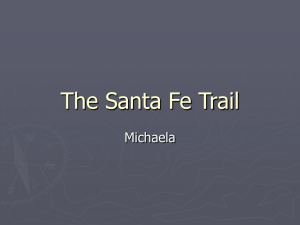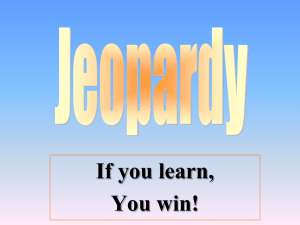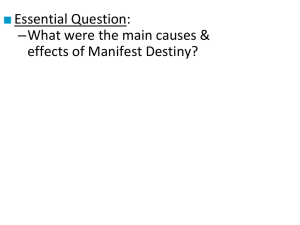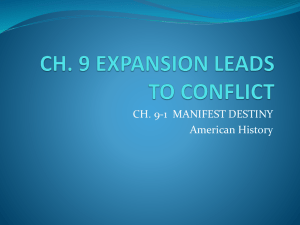Oregon Trail - therblig.com
advertisement
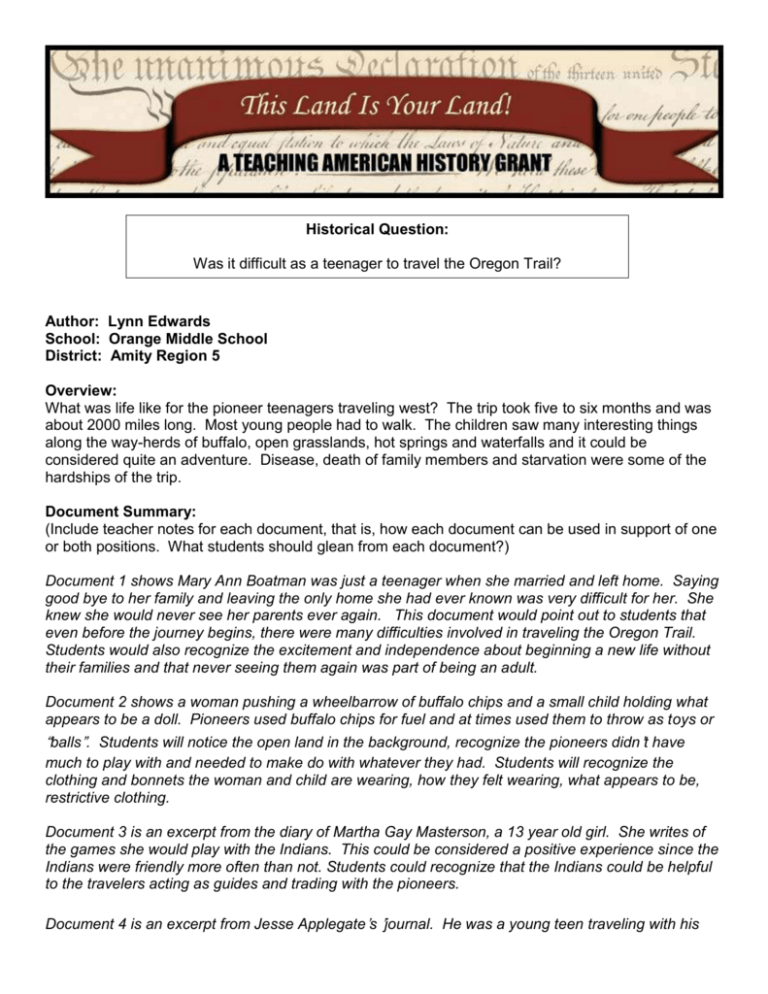
Historical Question: Was it difficult as a teenager to travel the Oregon Trail? Author: Lynn Edwards School: Orange Middle School District: Amity Region 5 Overview: What was life like for the pioneer teenagers traveling west? The trip took five to six months and was about 2000 miles long. Most young people had to walk. The children saw many interesting things along the way-herds of buffalo, open grasslands, hot springs and waterfalls and it could be considered quite an adventure. Disease, death of family members and starvation were some of the hardships of the trip. Document Summary: (Include teacher notes for each document, that is, how each document can be used in support of one or both positions. What students should glean from each document?) Document 1 shows Mary Ann Boatman was just a teenager when she married and left home. Saying good bye to her family and leaving the only home she had ever known was very difficult for her. She knew she would never see her parents ever again. This document would point out to students that even before the journey begins, there were many difficulties involved in traveling the Oregon Trail. Students would also recognize the excitement and independence about beginning a new life without their families and that never seeing them again was part of being an adult. Document 2 shows a woman pushing a wheelbarrow of buffalo chips and a small child holding what appears to be a doll. Pioneers used buffalo chips for fuel and at times used them to throw as toys or “balls”. Students will notice the open land in the background, recognize the pioneers didn ’t have much to play with and needed to make do with whatever they had. Students will recognize the clothing and bonnets the woman and child are wearing, how they felt wearing, what appears to be, restrictive clothing. Document 3 is an excerpt from the diary of Martha Gay Masterson, a 13 year old girl. She writes of the games she would play with the Indians. This could be considered a positive experience since the Indians were friendly more often than not. Students could recognize that the Indians could be helpful to the travelers acting as guides and trading with the pioneers. Document 4 is an excerpt from Jesse Applegate’s ’journal. He was a young teen traveling with his family. Students will recognize that even though there were many hardships on the trail, the young people looked at the experience as an adventure. This document points out that there were many evenings spent with friends and family singing and dancing. Document 5 shows that Mary Murphy, part of the Donner Party and 13 years old at the time, tells about the snowshoes being made and the adults attempting to reach California in December. This document shows Marys’ mother making the decision to send her older children and the younger ones will stay back. Students will recognize how difficult it was for families to decide, in times of crisis, what family members should be the ones to suffer, be brave or be left behind. How did families decide? Who were the ones to make these decisions? Were the younger people, because they were the “strongest” chosen to make the dangerous trek? Document 6 is a photograph of a family who seems to have traveled extensively on the Oregon Trail. Students can recognize that the wagons are torn and the clothing appears to be old. Students will notice the expressions on the children and adults faces. From the picture, does it look like life was easy for the family? A positive could be that they have arrived at their destination, tired, but intact as a family and still have all or some of the items they started off with on their journey. Procedure (80 minutes): 1. Introduction of lesson, objectives, overview of SAC procedure (15 minutes) 2. SAC group assignments (30 minutes) a. Assign groups of four and assign arguments to each team of two. b. In each group, teams read and examine the Document Packet c. Each student completes the Preparation part of the Capture Sheet (#2), and works with their partner to prepare their argument using supporting evidence. d. Students should summarize your argument in #3. 3. Position Presentation (10 minutes) a. Team 1 presents their position using supporting evidence recorded and summarized on the Preparation part of the Capture Sheet (#2 & #3) on the Preparation matrix. Team 2 records Team 1’s argument in #4. b. Team 2 restates Team 1’s position to their satisfaction. c. Team 2 asks clarifying questions and records Team 1’s answers. d. Team 2 presents their position using supporting evidence recorded and summarized on the Preparation part of the Capture Sheet (#2 & #3) on the Preparation matrix. Team 1 records Team 2’s argument in #4. e. Team 1 restates Team 2’s position to their satisfaction. f. Team 1 asks clarifying questions and records Team 2’s answers. 4. Consensus Building (10 minutes) a. Team 1 and 2 put their roles aside. b. Teams discuss ideas that have been presented, and figure out where they can agree or where they have differences about the historical question 5. Closing the lesson (15 minutes) a. Whole-group Discussion b. Make connection to unit c. Assessment (suggested writing activity addressing the question) DOCUMENT PACKET Document 1 Women married early in those days, and it’s not uncommon to read about fifteen-year-old brides traveling the Oregon Trail. Mary Ann Boatman, who was nineteen when she went west with her husband Willis, wrote about leaving home: About 10 o’clock everything was loaded into the big ox wagon. Then came the hardest task of all, for me, to say goodbye. But the time had come … a loving embrace,… a farewell kiss, a “God bless you all.” Yes, I stepped out of that dear old house that had been my home all of my life … never to enter it again, nor to see my loving mother again … Yes, as I said, the time had come. I walked out over the path that I had trod all my short life where I had sported and played with my brothers and sisters and schoolmates. Everything looked so dear to me that morning. Dear father opened the old gate for me, then helped me …climb into the big wagon. Then came the words “gee, whoa, get up Deke and Dime, Buck and Brite.” Those were the oxen’s names … The whip cracked and we were off. Vocabulary Embrace: hold someone closely in ones arms as a sign of affection Trod: walk in a specific way Oxen: a cow or bull kept for milk or meat Source: (From Surviving the Oregon Trail, 1852 by Weldon Willis Rau.) http://www.ci.tumwater.wa.us/researchOTpg11.htm Document 2 If you think Frisbees are inventions of the 1960’s…..think again! Children traveling the Oregon Trail threw Frisbees like devices in the 1800’s but they weren’t made of plastic, they were made of buffalo dung. The entire Great Plains region was covered in buffalo chips and children occasionally tossed them about in a Frisbee-like manner. Source: The Oregon Trail http://www.america101.us/trail/buffalo.html Document 3 Many of the young people were afraid of encounters with Indians. They thought they would be kidnapped or hurt. Usually the Indians were only interested in trading or visiting and were friendly. Martha Gay Masterson (13 years old when she traveled west): "One pleasant evening some Indian boys wanted to display their skill with bow and arrow. When we gave them a biscuit they would set it up, step off some distance and pierce it with an arrow. Father got a pan of biscuits and he would measure off a distance, set up one and tell them to shoot at it. The one who struck it first got it for his own. They had considerable sport over the biscuits." "We never needed to stop the wagon to let us in or out. The teams were very gentle, and we could get out and walk a while, then get into the wagon again and not trouble the teamster." Vocabulary Biscuit: a small cake of shortened bread leavened with baking powder Considerable: having merit or distinction Teamster: one who drives a team Source: Just for Kids-Trail Kids Oregon/Washington BLM http://www.blm.gov/or/oregontrail/education-kids-trail.php Document 4 Jesse Applegate traveled the Oregon Trail in 1843 with his parents, brothers and sister and a number of relatives. The Applegate party journeyed across the prairies and over the Rockies. He had traded bits of metal and nails with Indian children and thrown buffalo chips at other children. Applegate wrote about the workings of a typical evening on the trail: 'After supper, the children played their favorite games, the elders gathered in groups and talked, perhaps making plans for the new homes to be built at the end of the Oregon Trail. Some of the young folk danced to the music of the fiddle or accordion, while those more serious minded sang their favorite songs, some religious, some sentimental. 'Old Hundredth' was a favorite, and as the music and words of the grand old hymn floated on the evening breeze, many paused to listen and ponder. But youth was not to be denied, the trek was a great adventure, and life stretched far ahead. Many a troth was plighted at the impromptu gatherings along the trail, beside a dim campfire. Vocabulary Elders: greater than another in age or seniority Ponder: to reflect or consider with thoroughness and care Troth: truth; loyalty Plighted: to promise or bind by a solemn pledge Source: Oregon Trail: Wagon Tracks West http://www.historynet.com/oregon-trail-wagon-tracks-west.htm Document 5 The Donner Party became notorious in the history of the westward migration for reported claims of cannibalism. They began their expedition in April 1846 with 87 wagon trains. They were unable to cross the Sierra Nevada before winter and almost one half of their party starved to death. Wednesday, December 16, 1846 Mary Murphy, who was thirteen at the time, gave an account many years later to Mr. S. Hunt of Marysville: "A few weeks later Mr. Graves came to our place to talk with Mother. I remember him saying, 'I've just finished making seventeen pairs of snowshoes out of wagon bows and oxhide. If the strongest set out on foot, we could make it. That will leave what food there is left for the children and the weaker company members. Are there any in your cabin, Mrs. Murphy, that want to go? It is our only choice.' Of the eight of us in the cabin, Mother, who was going blind and needed attention, nevertheless dispatched Sarah, Harriet and Lemuel, leaving us babies as well as Mr. McCutcheon's child, for she was going to join the party." Thirteen year old Virginia Reed wrote a letter on May 16, 1847 to her cousin Mary: "it would snow 10 days before it would stop they waited til it stopped & started again I was a going with them & I took sick & could not go on--there were 15 started" Vocabulary Oxhide: leather made from the hide of an ox Dispatched: send off to a destination or a purpose Source: Donner Party Diary: http://www.donnerpartydiary.com/dec46.htm Document 6 Many people went to the Oregon Territory to get free land. Some people went hoping to get better health or better living conditions. Some people went to escape their problems and others went for adventure and to seek new experiences. Tired Travellers Source: http://www.wou.edu/~aamiller06/Oregon%20Trail/arrival.html Some of the language and phrasing in these documents have been modified from the originals. CAPTURE SHEET D o n Was it difficult for a teenager to travel the Oregon Trail? ’ t f o r Preparation: g 1. Highlight your assigned position. e t Yes: It was difficult being a teenager on the Oregon Trail. No: Life was not difficult for teenagers on the Oregon Trail. t h e 2. Read through each document searching for support for your side’s argument. Use the documents to fill in the chart (Hint: Not all documents support your side, find those that do): r u Document # What is the main idea of this document? What details support your position? l e s o f a s u c c e s s f u l a c a d e m 3. Work with your partner to summarize your arguments for your position using the supporting i documents you found above: c c o n t Position Presentation: 4. You and your partner will present your position to your opposing group members. When you are done, you will then listen to your opponents’ position. While you are listening to your opponents’ presentation, write down the main details that they present here: Clarifying questions I have for the opposing partners: How they answered the questions: Consensus Building: 5. Put your assigned roles aside. Where does your group stand on the question? Where does your group agree? Where does your group disagree? Your consensus answer does not have to be strictly yes, or no. We agree: We disagree: Our final consensus:



